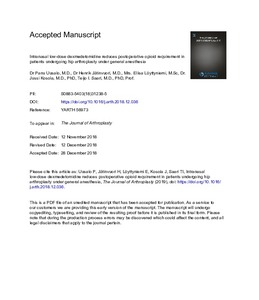Intranasal low-dose dexmedetomidine reduces postoperative opioid requirement in patients undergoing hip arthroplasty under general anesthesia
Uusalo Panu; Jätinvuori Henrik; Löyttyniemi Eliisa; Kosola Jussi; Saari Teijo I.
https://urn.fi/URN:NBN:fi-fe2021042821932
Tiivistelmä
Background: Patients undergoing total hip arthroplasty (THA) need substantial amount of opioids for postoperative pain management, which necessitates opioid-sparing modalities. Dexmedetomidine is a novel alpha-2-adrenoceptor–activating drug for procedural sedation. In addition to its sedative effect, dexmedetomidine has analgesic and antiemetic effects. We evaluated retrospectively the effect of intraoperatively administered intranasal low-dose dexmedetomidine on postoperative opioid requirement in patients undergoing THA.
Methods: We included 120 patients with American Society of Anesthesiologists status 1-2, age between 35 and 80 years, and scheduled for unilateral primary THA under general anesthesia with total intravenous anesthesia. Half of the patients received 50 μg of intranasal dexmedetomidine after anesthesia induction, while the rest were treated conventionally. Postoperative opioid requirements were calculated as morphine equivalent doses for both groups. The impact of intranasal dexmedetomidine on postoperative hemodynamics and length of stay was evaluated.
Results: The cumulative postoperative opioid requirement was significantly reduced in the dexmedetomidine group compared with the control group (26.3 mg, 95% confidence interval 15.6-36.4, P < .001). The cumulative dose was significantly different between the groups already at 12, 24, and 36 h postoperatively (P = .01; P = .001; P < .001, respectively). Dexmedetomidine group had lower mean arterial pressure in the postanesthesia care unit compared with the control group (P = .01). There was no difference in the postanesthesia care unit stay or postoperative length of stay between the two groups (P = .47; P = .10, respectively).
Conclusion: Compared with the control group, intraoperative use of intranasal low-dose dexmedetomidine decreases opioid consumption and sympathetic response during acute postoperative period in patients undergoing THA.
Kokoelmat
- Rinnakkaistallenteet [27094]
